
Joe's Stories from the Road
for March and April 06
the month of March 06
March 16
On the Road again - the final 4,000
On March 11, Barbara drove me to Cleveland, Tennessee
to begin the last leg of the 14,000-mile bicycle trip. I knew I was
going to miss her, especially, and the grandchildren and children.
But I made a commitment to do a 14,000-mile bicycle trip and that
means I have another 4,000 miles to ride.
We visited on the way down and talked into the
evening. I was dreading leaving her yet again. She stayed with me
during the first day back so she drove and carried my luggage in the
car. I rode from Cleveland to Murphy, North Carolina. Shortly after noon my nephew,
Steve Bowen and his wife Stephanie, showed up at the site of the
boating sports of the 1976
Atlanta summer Olympic Games. On the back of his automobile was a large
painted sign that read:
RIDE JOE RIDE TO BOWEN, KY. Thanks, you guys. It was a treat. The
next morning Barbara left for Kentucky. I took the day
off because of rain. And again I was on my own. Love you, Barbara,
and thanks for putting up with me and the bicycle trip. You are an
awesome lady and I love you very much.

Steven and Stephanie
The next day out I stopped at a restaurant for
lunch. A man walked in and came over to my table. “You are Joe
Bowen?” He said. “You talked to my high school back in the sixties
when you were on a big cross country bicycle trip.”
“Yes,” I answered, “What high school did I talk to?” Then the
53 year old man replied, “Powell County High School in Stanton, Kentucky.”
He was Roger Powell from Stanton who had made a career as a soldier
with the US Army and retired and moved to Murphy,
North Carolina. He and his wife, Hope, set
down and ate lunch with me.
I met and talked to a large group of bicyclists
in the mountains and they said that they may be able to come and
race in the bicycle race that we are hosting in the Red River
Country on June 17 of this year. I had lunch today with two cyclists
who are college students in Austin, Texas.
They were Alex Ratzel from New Mexico
and Daniel Driver from
Weatherford, Texas. Great young men.
I enjoyed our visit, fellows.
I rode over the mountain in the Great Smoky Mountain
National Park into Gatlinburg. In 16
miles I gained over 3,000 feet in elevation. That will probably be
my last big mountain of the trip. There will be some tough ones in
West Virginia,
Pennsylvania, and New York but none as high. It was extremely
cold at the top but I made it back down to warm weather.
North of Gatlinburg I met with Sam Moseley who
does a lot of brochures for
Kentucky tourism. While there I had a great talk with his son Austin Branham.
Austin is eleven years old. And there is no doubt in my mind that one of
these days we will hear that
Austin is an Astronaut and is flying in space. He is an incredible young
man and it was my pleasure meeting him. The best to you, my new
friend Austin.
Today I made it to Greenville Tennessee. This is the hometown of
US President Andrew Johnson. In his library I found two letters to
the president and one from the president about a trial in Indianapolis, Indiana.
The trial was the one that involves a man from Taylorsville, Kentucky,
Felix Grundy Stidger. Stidger was the star witness in a trial about
treason. There are some of you who know what I am talking about. I
don’t have the time right now to write about this but will later.
Thanks to all of you for checking in with the
web site and wishing me a safe journey back to
Kentucky.
Sincerely, Joe Bowen
the Month of April 06
April 5
Tennessee incident, Wild, Wonderful, West Virginia, Steinbeck (again), River of Earth, Dogs
I have been enjoying the wonderful ride across West Virginia so much
that I have gotten behind on my writing. So let me back up…
There was a little incident that happened the
first five miles into the restart of the bicycle trip out of Cleveland, Tennessee,
that I wanted to share. I thought maybe I wouldn’t write about it
but then, what the heck. Barbara had let me out and we put all the
gear on the bicycle. I saddled up on Rocinante and rode away east
toward North Carolina. It was good being back on the
bicycle again. All of a sudden, something hit me on my left thigh.
It hurt. Someone had thrown something out of a passing car window. I
braked and saw a can of seven-up spewing on the shoulder of the
highway. Someone had intentionally tried to hit me. And was
successful! The car didn’t stop or slow down. I was mad. I wasn’t
seriously hurt but I was extremely angry. If only he could have
heard what I screamed at him. And I try not to do that.
After putting the can on the bicycle I
continued on down the highway. About a mile up the road I saw the
car had pulled into a small market. We were going to have a talk. I
pulled over near the car and a tall young man got out. “I am sorry,
sir. I didn’t mean to hit you.” “I can accept that,” I told him. “It takes a pretty big man
to stop and tell me rather than go on down the road.” I pulled my
book out and asked him to write something in it about what had
happened.
This is what he wrote:
3-12-06 I,
Ricky Lee Gray, apologize for being out of control and throwing a
can out of the window and hitting this good man.
Sorry. Ricky
Gray.
Ricky may never look at this website but he
made my day. I have told this story many times and have shown people
his note in my book. Ricky is a good man. Ricky had tattoos on his
arms and most of us would have judged him wrongly. Including myself.
But Ricky has good stuff in him and my hat is off to a man that
can’t laugh with his buddies and go on down the road. And his
buddies were in the car with him. The goodness in Ricky made him
wait on me and make things right. Thank you, God, and thank you,
Ricky.
West
Virginia. What a place and what incredibly
wonderful and friendly people. I kept hearing in my mind, “Wild,
Wonderful West Virginia.” It really describes the people and the
place. This may get a little long but I have a need to share this
with you and especially those incredible children in
Eastern Kentucky that are following the bicycle trip. (I
just got some email from Botts and Red River Elementary saying that
the children are back on the website following me. Thanks to all of
you and I really was impressed with you and your schools and
teachers when I visited this winter.)
During the Great Depression two writers wrote
about what happened to the American family during this painful time
in our history. The author that we all know about was John Steinbeck
who wrote the story about a poor family making their way from
Oklahoma to California trying to
survive during that time. The book Steinbeck wrote was “Grapes of
Wrath.” The other great author was Kentuckian James Still who wrote
about the families in Eastern Kentucky who were trying to survive
the same Great Depression and drought that had plagued
America. Still’s book was titled “River of Earth.”
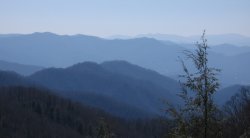
It has been a long time since I read “River of
Earth” but in my memory there is a Mountain Preacher who is giving
it his all one Sunday morning.
And he describes us being on this river of earth.
The preacher was influenced by the Cumberland Mountains and
how God made them. And
these are the same mountains that I have crossed going almost
straight east. These
mountains are gigantic spines of rock and dirt that have pushed
themselves out of the Earth’s floor.
They are the most rugged mountains that I have crossed during
this entire bicycle trip of 10,700 miles so far.
The mountain preacher preached that these huge mountains were
like waves on a river.
Only these earthen waves travel a few inches in a million years.
Traveling on a bicycle across the waves of earth is
fascinating as I think of that good old Country Preacher in Still’s
“River of Earth.” For
several days this went on. The bicycle would coast me down the falling side of the great
earth wave. At the
bottom I would start pedaling back up the other side of the next
wave. Then I would top
the wave of earth and I could see the whole River of Earth as far as
I could see. And then
dip down into the trough of the next wave only to have to pedal back
up to the top again.
For the teacher, I would get a West Virginia map and show the
children how all the rivers run northeast in a pretty much straight
line. The backbones,
these spines of earth, are in between each of these rivers.
Several years ago I had the wonderful experience
of flying over Eastern Kentucky and West Virginia in a small
airplane. From up there
you can plainly see this River of Earth.
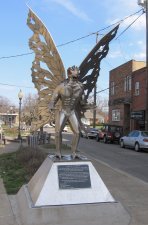
The Mothman
Before I started into the mountains I had to stop at Pt. Pleasant, West Virginia, on the Ohio River. My nephew told me that I had to stop there. So I did. Back in the 1960s several people in that area said that they had seen a man that had wings and looked like a giant moth. The sightings were so frequent that the local newspapers actually wrote stories about people seeing the mothman. I saw several of the articles reprinted in a book. These sightings happened in 1966. And some of the people believed that the mothman was trying to warn them of a disaster. Then in December 1967 the Ohio River bridge at Pt. Pleasant fell into the river. All three spans of the bridge collapsed. Forty-six people died during the bridge failure. And the mothman was never seen again by anyone. Less than a block from the entrance to the Silver Bridge that fell there is a life-size statue of the mothman standing on an island in the street. Think what you may. I am just sharing with you what I read and saw.


I talked to a lot of great people while riding across West Virginia. Friendliest people you will find anywhere. But beware of their dogs. I was chased and barked at by more dogs in West Virginia than I have been on the entire trip. I can outrun a dog if I see him coming. I hope that I will always be able to tell you this. But in West Virginia two dogs made it all the way up to the pedals. That means that they were close enough to bite but just were going too fast to run and bite at the same time. When I got to the last mountain climb before going into Virginia a big, big, black dog started to chase. Then he became playful. I stopped at the top of the mountain and played with him. I finally got a photo of him with the bicycle. It was like he was saying, “Bicycle Man, we didn’t really mean you any harm while you bicycled across our great state. We just wanted to see how fast an old man could pedal a bicycle.” I told him farewell as he started out down the mountain after me. I looked back and he gave up the chase. I was on my way to Virginia.

Nice puppy. He was just kidding in the above pictures.
April 7
Bicycling Judge Sanders, Canal, Washington D.C., KY Congressmen, John David Morton
Outside of Winchester, VA, on my way to Harper’s Ferry, WV, I met a gentleman on a bicycle who would become a great asset to the children following the bicycle trip. I stopped at a small market to rest and get a Gatorade to drink. David H. Sanders, on his bicycle, started asking me about the bicycle trip. I was equally interested in what he may be doing. He invited me to ride some back roads that would be safer on my way to Harpers Ferry. Sounded good so we rode his route for over 25 miles. I learned that he was going to India for a couple of weeks with a friend just to look around. No tour or specific plan. I told him about working with the elementary children in Eastern Kentucky and that I was going to Harpers Ferry to see if I could find them an interesting story. I was especially interested in John Brown, the abolitionist who gets some credit for starting the Civil War. David then told me that he was a Circuit Judge and served in the same Courthouse where John Brown was tried, found guilty, and sentenced to be hanged. And he was hanged on the courthouse square. David said that he would e-mail you guys and tell you about himself. Great! And thanks, David. It was great riding with you. You are the only judge that I know who enjoys riding a bicycle. Of course, I don’t know very many judges.
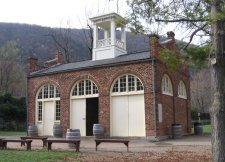
US Armory captured by John Brown
Harpers Ferry is a strange little town built on the side of a steep mountain. The streets are so steep that it was all I could do to pedal up them. It is at Harpers Ferry where two great rivers, the Shenandoah and the Potomac, come together and head to the Chesapeake Bay and from there out to sea. At Harpers Ferry I crossed the Appalachian Trail for the third time. I first crossed it in North Carolina then on the Tennessee/North Carolina border on the top of New Found Gap in the Smoky Mountains. And it was in Harpers Ferry that I discovered an incredible route to downtown Washington, DC. I walked Rocinante across a train trestle that crosses the Potomac. The trestle has a walking bridge attached to the side of it. On the other side I had to carry Rocinante down a long flight of winding stairs to the C & O Canal Tow Path. And then we were on our way to the Nation’s Capitol. For sixty-three miles I rode under a canopy of large trees on a narrow gravel road. The trees and flowers were blooming and the new frogs were making a big racket in the water holes of the old canal. I was actually riding on the path where the mules and horses walked as they pulled the canal boats loaded with goods headed to the middle of America. The old lock-keepers homes are still there and in good condition. All are made of brick. To the left of the towpath was the canal and to my right was the mighty Potomac.
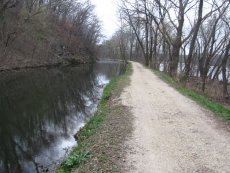
Canal, tow path, Potomac River
David has told you most of this but I have to
tell you, too. Late that evening I got caught in a horrible lighting
and rainstorm. I thought it was going to blow my little tent over.
For about an hour it was very frightening.
I spent two days looking at all the sites in Washington and visiting
with several congressmen from Kentucky. I talked to
Congressman Hal Rogers who represents Southern and Eastern Kentucky,
Congressman Ben Chandler who represents us in
Powell County, and Congressman Ron Lewis who
represents us in Spencer County. I am one of the
lucky people that have two homes, Stanton
and Taylorsville, and therefore have two congressmen. I also
had a good visit with the folks that run the League of American
Bicyclists. They are the folks that are encouraging Americans to
ride a bicycle so we can live healthier lives, have a lot of fun and
save our precious oil resources. After visiting the Congressmen, I
stopped down on the mall so I could look back and see the US Capitol
Building. I wanted to get a photo of Rocinante with the Capitol in
the background. While standing there I got into a conversation with
two men. One was from India and the other from
England. “In that building are made
the decisions that control the whole world.” One of the gentlemen
commented. “I pray to God that they always remember the awesome
burden on their shoulders and make the right decisions for all the
people of the world.” I replied. The men agreed and we stood and
talked about how profound the decisions were that come out of that
one building on this great Earth.

Capitol Building of the United States
It was incredible visiting with our congressmen and the League of American Bicyclists. It was a treat to get to bicycle around the great mall and visit the Roosevelt Memorial, the World War 11 Memorial, the Vietnam War Wall, the Korean Conflict Memorial, Jefferson Memorial, the Lincoln Memorial and the many other famous places. But none of these were remotely important to me as my visit to Arlington National Cemetery.
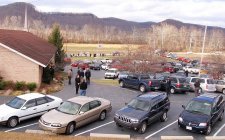
Memorial Service in Bowen, KY
While I was in Kentucky
during the winter a neighbor who was raised on nearby Cane Creek,
just across the Red River from us, was killed while serving the US
Army in Afghanistan. The
soldier was SFC John David Morton. I attended his memorial service
at the Bowen First Church of God. The outpouring of love and
compassion for the family was overwhelming. John had requested he be
buried in Arlington Cemetery
when he passed on. No one knew it would be so soon. The evening
before I was to get back on the bicycle trip, Mr. and Mrs. Jerry
Morton came to our home and asked me to visit their son’s grave
while I was in Washington. It was humbling and a great honor
that they would ask me to do this.
At
Arlington I was given a pass so I could ride the bicycle to John David’s
grave. I wanted to get a photo of Rocinante and me beside the grave
but I wasn’t sure how I could do that. I was alone and there was no
one on the Bradley Street of the cemetery. When I got
down to Section 60, a man and wife walked up to me. I told them who
I was looking for. It was a beautiful sunny day with blue skies and
the Washington Monument glistening across the Potomac. A
stiff, cool wind was blowing. The couple, Wayne and Julie Loehring
from St. Louis, Missouri,
walked with me to John David. I didn’t think it would be this way,
but it was very emotional for me.
Wayne took several photos of me beside John David. Then they turned and
asked if I would take their photo with him also.
Wayne had been a career military man and he said that it was an honor to
be here with me and hear John David Morton’s story. They said to
tell John David’s mom and dad that he would live in their memory
also.

John David Morton, Arlington Cemetery
Wayne pointed out something to me that I felt that
Jerry and his wife might not have known.
But just over on the next little rise are buried the people
who lost their lives during the terrorist attack on the Pentagon on
September 11, 2001.
I went to high school at Powell County High School
in Stanton, Kentucky, with Jerry Morton, John David’s father.
It was a great honor to me to be asked to visit and then to
stand by John David Morton’s final resting place on a cold sunny day
overlooking the Potomac River and the city of Washington, D.C. I
thank God for the men and women who are willing to give their all so
that we can live as free men, women and children on this earth.
April 10
Barricades, Security; then and now, Gettysburg
I have been thinking about all the
good that happened in Washington, DC.
And the good is what I most enjoy talking about.
But let’s take one more look.
In 1968, when I got to Washington I actually ended the trip
at the Nation’s Capitol.
My Congressman at that time was Congressman John C. Watt.
I stopped at his office in the Rayburn Building and just
rolled the bicycle into his office.
I caught him at lunchtime and he had one of his aids to go
out and get me a sandwich and cold drink.
Then he took me through the transit system to the capitol
building and with a pass, I sat in the gallery and watched business
go on. Today, I
probably would not even be allowed in the House Transit System.
And when I approached the Rayburn Building entrance my bags
were searched, my shoes had to be taken off and x-rayed, my bags
were x-rayed, and then I was permitted in.
The next day when I went to my other appointments, and one
was in the Rayburn Building, they would not let me take the bicycle
in. They didn’t believe
that I had taken Rocinante in the day before until I showed them a
photo of Rocinante in Congressman Roger’s Office.
When I pedaled up to the Capitol
Building in 1968 I went wherever I needed to go. And automobiles
also went where they wanted around the
Capitol Building. Now,
barricades prevent a vehicle from even getting close to the Capitol.
It is sad that we have to do this but it is a different time
than in 1968. At all
the memorials, the Lincoln, the Jefferson, the Vietnam Wall, all of
them are barricaded where an automobile cannot even get close.
In 1968 you could drive around the Lincoln Memorial; but not
anymore. At the White
House in 1968 you could drive your car around the outside of the
iron fence. Not
anymore. Now, the
streets in front and back of the White House are closed to all but
walking visitors. In
all of the State Capitol Buildings that I visited this time I had to
go through x-rays. The
only state Capitol I visited this trip that didn’t have security at
the front door was in Montgomery, Alabama.
In 1967 and 68 I had to fly with the bicycle as I had to this
time. In 1967-68 I
simply wheeled the bicycle to the conveyor belt going up into the
plane, walked around, and then walked up the steps to board.
When we landed, I got off and walked around the plane and
waited for my bicycle to come back down the conveyor belt.
I took it off and rode out of the airport from the plane.
You remember what all I had to do when I had to fly out of
Scottsbluff, Nebraska, airport when I went home for my buddy
“Beanie’s” funeral? Our
world is still good and we can make it even better.
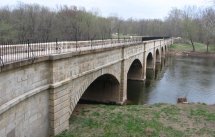
Your boat is in the canal on top of the aqueduct, not in the river below.
And a little more about the C & O Canal.
My brother, JL, had ridden some of the canal in Cumberland, Maryland,
a few months ago and had told me about it but I had forgotten. We
talked about it again the other night. I still cannot believe that
you can ride a bicycle or walk 181 miles on a gravel road into
downtown Washington, DC.
During that ride or walk you will have to go through a tunnel that
is 3,100 feet long. I will have to come back with grandchildren,
bicycles, and flashlights and do that part. To see the old inlets to
bring the water into the canal and to see the old locks still there
is just amazing. And several of the locks are still functioning.
They have the wooden gates still attached and the National Park
workers will flood the lock and show you how the boats were raised
and lowered so they could continue on their journey.
Today, on my way to
Gettysburg, I stopped by a historic marker
that said nearby was the birthplace of Francis Scott Key. Man, this
place is full of American History. I stopped at
Gettysburg and walked
through a large portion of it. The battle was all over town and in
every direction from the little town of
Gettysburg. I stopped near the place where
Lincoln
gave the incredible Gettysburg Address. In town, I stopped by the
home where Lincoln stayed the two nights that he was in
Gettysburg for that
awesome occasion. And for you children, and adults, just as a
reminder so we will not forget:
Four score and seven years ago our fathers
brought forth on this continent a new nation, conceived in liberty,
and dedicated to the proposition that all men are created equal.
Now we are engaged in a great civil war,
testing whether that nation, or any nation so conceived and so
dedicated can long endure.
We are met on a great battlefield of that war.
We have come to dedicate a portion of that field as a final
resting place for those who here gave their lives that that nation
might live.
It is altogether fitting and proper that we
should do this. But in a larger sense we cannot dedicate, we cannot
consecrate, we cannot hallow this ground. The brave men, living and
dead, who struggled here, have consecrated it far above our poor
power to add or detract.
The world will little note, nor long remember,
what we say here, but it can never forget what they did here. It is
for us, the living, rather to be dedicated here to the unfinished
work, which they who fought here have thus far so nobly advanced.
It is rather for us
to be here dedicated to the great task remaining
before us, that from these honored
dead we take increased devotion to that cause for which they gave
the last full measure of devotion; that we here highly resolve that
these dead shall not have died in vain;
that this nation under God, shall have a new birth of
freedom, and that this government of the people, by the people, and
for the people shall not perish from the earth.
Lincoln’s address at Gettysburg on November 19, 1863